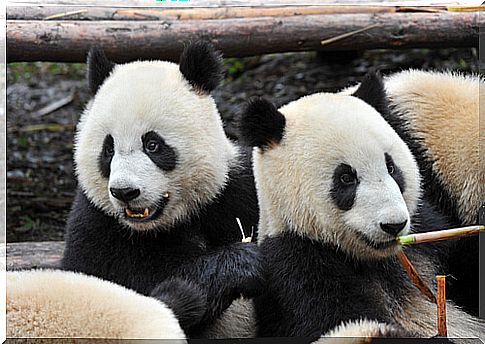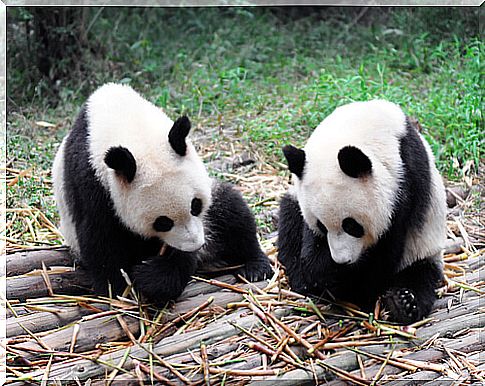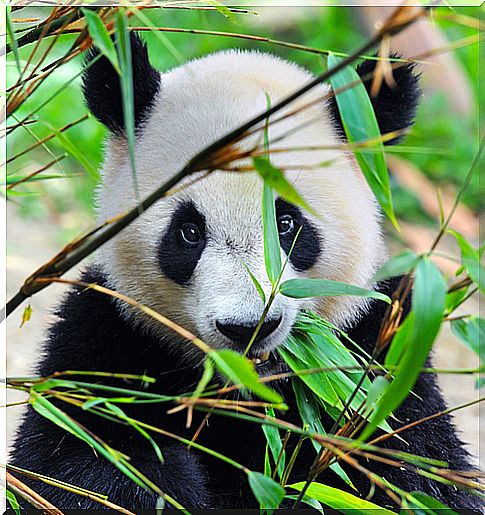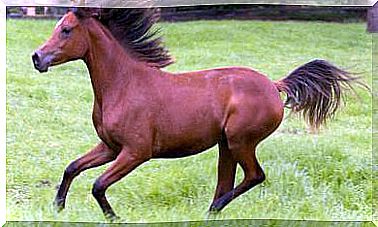The Panda Bear: Characteristics, Behavior And Habitat

The panda bear, also called “giant panda”, is a very unique mammal. It is generally known for its love of bamboo and for being at the top of the list of endangered animals for more than twenty years. And although they recently emerged from it, they are still in a vulnerable position.
Although today there are around 2000 specimens living in the wild, many remain in captivity, in sanctuaries. Hence, this animal has become the symbol of environmental protection and the image of such important organizations as the WWF ( World Wild Fund for Nature ).
The panda bear and its characteristics
Their general appearance, measurements and certain behavioral traits are similar to those of other bears. However, something that differentiates it significantly is the color pattern that its coat presents. These are very well defined black and white spots in areas such as the ears, eyes and legs.

Obviously, it is a stout mammal, with very well developed musculature, especially in its front extremities; thanks to this, he manages to climb and swim. It can weigh up to 150 kilograms and can stand up to 1.9 meters tall.
It should be noted that the panda bear has a very particular trait: on its front legs it has “a sixth finger”, which it uses as if it were a thumb both when climbing and when trying to reach its food. It is not actually a thumb as such but a modification to your wrist bone.
Habitat and food
Its natural habitat is the bamboo forests and mountain ranges of Central China and Tibet; however, given that most of these forests have been destroyed, they have had to resort to their captivity in sanctuaries and reserves of animal life.
Unlike other bears, the panda does not hibernate. However, it does descend to warmer areas in winter and spring seasons when it is in the wild. One of the reasons for this behavior is very simple: the climate of its natural habitat does not force it to hibernate.
Although its digestive system is carnivorous, its favorite food is bamboo. Now, their diet is omnivorous; that is, you can consume foods of animal origin, such as: small rodents, birds, eggs and insects. However, they are consumed occasionally.

The panda bear is an animal that can spend up to 14 hours feeding, since it needs to consume between 12 and 38 kilos of food a day to satisfy its nutritional needs.
Behavior
It is a solitary animal, since it is very territorial. It delimits its space very well through urine, mainly. It does not usually seek the company of other pandas, except in specific moments, nor does it tolerate the invasion of its space by other pandas, with the exception of cubs.
Regarding his activity level, this is low, since he is basically limited to eating and sleeping. In this sense, it can be said that it is a calm animal. And something that is undoubtedly very striking is their way of mating.
To begin with, they reach maturity between 5 and 8 years of age and copulation is usually brief. Likewise, it should be noted that a panda bear can give birth to 1 or 2 cubs every two years. These young do not become independent until after 3 years of age.
Finally, it is necessary to point out that there is a subspecies known as Qingling , which has a coat in shades of brown with a pattern equal to the black and white panda bear. However, this subspecies is smaller than the giant panda. The researchers hypothesize that the color variation is due to an environmental factor.









